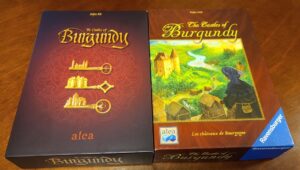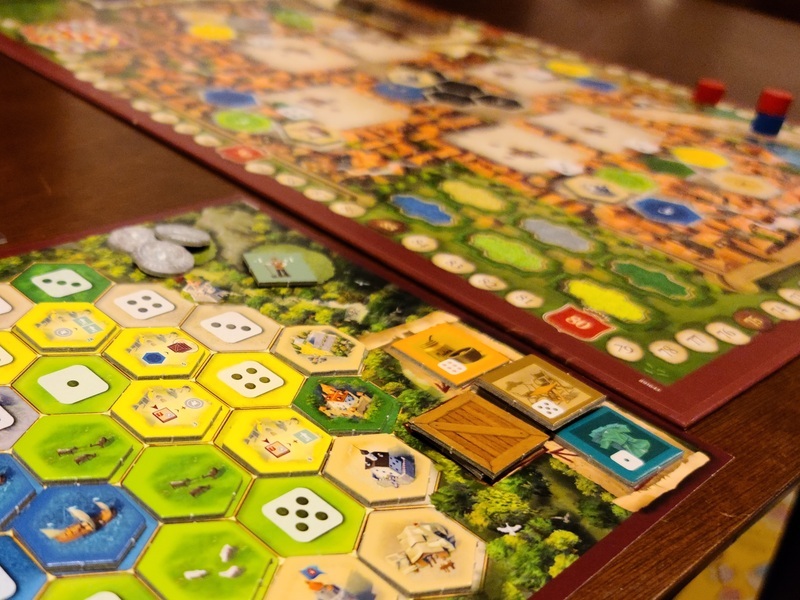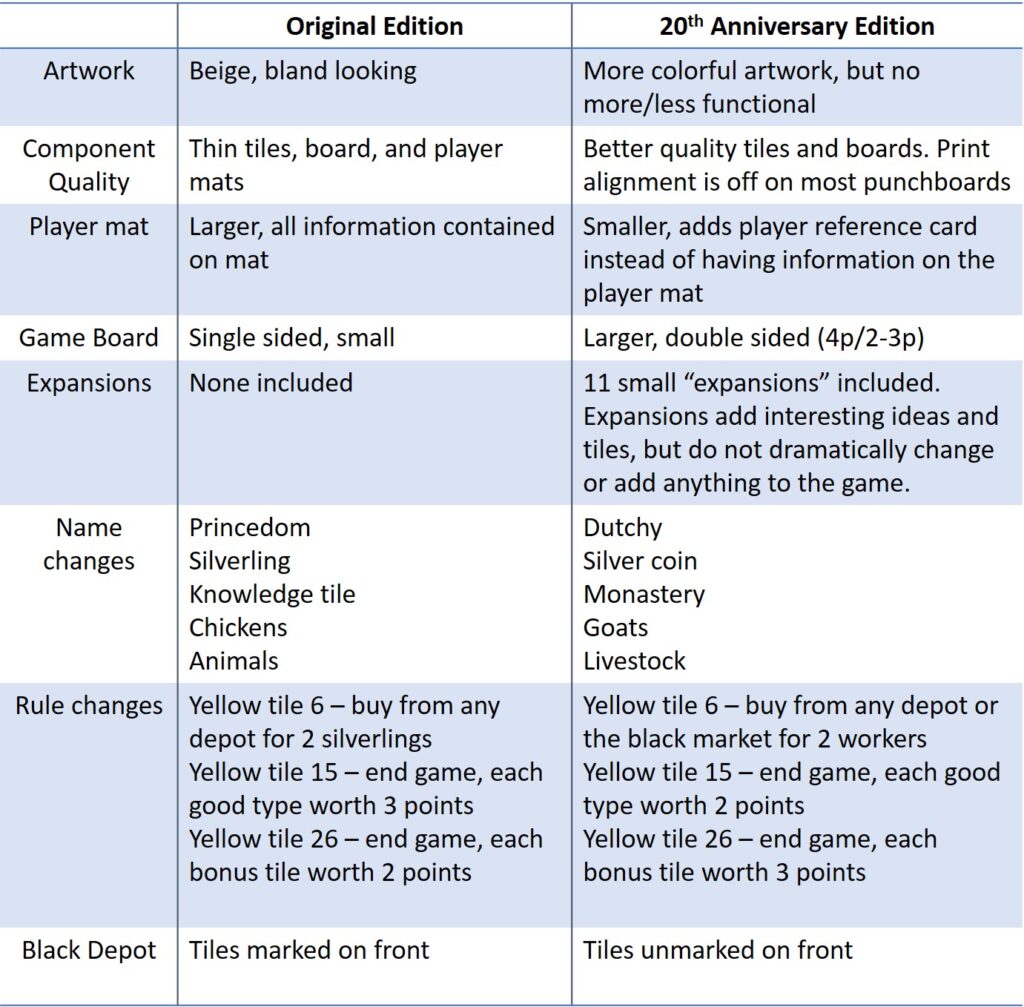Dice selection and manipulation, tile selection and placement point salad game for 2-4 players
30-90 minutes
Castles of Burgundy plays 2-4 players, but truly shines at the 2 player level. It’s quick, elegant, competitive, and oh so satisfying to string combos together for a huge score. This point salad of a game from prolific designer Stefan Feld balances challenging strategy with diverse gameplay.

Emily is particularly susceptible to judging a game by its box art, but we’re glad we ignored the beige color scheme. The Castles of Burgundy is more than its underwhelming artwork (and yes, even the updated 20th anniversary edition has underwhelming artwork). Despite the artwork fit for a thrift shop landscape print, it continues to one of the most popular Euro games.
Castles of Burgundy holds a special place in our hearts, since it was one of the first Euro games in our collection. Many games have come and gone over the years, but this one remains at the top of our list of favorites. Why? For us, it’s the perfect balance of challenging strategy for two players in a 40-60 minute package.
Gameplay Overview

In The Castles of Burgundy players manage their individual player mats and manipulate dice rolls to build their own dutchy while competing for tiles on the central board and vying for turn order. Players aim to build regions (colored sections) in their dutchy to gain depreciating completion bonuses. A typical turn goes like this:
- Players simultaneously roll their two dice.
- The first player rolls a white die along with their player dice to assign one good tile per turn to the depot of the corresponding value of the white die.
- In player order, players do one action per die.
- Take a tile from the central board and place in reserve on their dutchy board.
- Place a tile from their tile reserve onto their dutchy.
- Tiles gain additional effects when placed:
- Buildings (brown) – Give additional benefits based on building type (see player aide).
- Ships (blue)- Take goods from a shipping depot. Advance on turn order track.
- Farms/Livestock (light green) – Score points based on number of animals on the tile and of the same type within the farm.
- Mines (gray) – Gain 1 silver coin at the end of the age per mine
- Castles (dark green) – Take any free action.
- Knowledge/Monastery (yellow) – End game scoring or other benefits within the game.
- Tiles gain additional effects when placed:
- Exchange dice for 2 workers.
- Sell goods.
- Players may use worker tiles to manipulate the die roll +/- per worker used.
- At any point during their turn, a player may purchase a tile from the central depot for 2 silver coins.
- The first player to fill in all spaces of a color receives the large bonus tile. The second player to fill all of that color receives the small bonus tile.
- Check turn order.
- Repeat numbers 1-6 until the end of an age and reset the board.
Each game is different with 16 player boards to choose from (not including the solo and team boards). Long-term planning needs to be a priority, but players must be flexible enough to incorporate the luck elements introduced by random tile availability and other players’ actions.
We do need to address the obvious elephant regarding the two versions of the game. We actually own both the original and the 20th anniversary edition. What are the differences you ask? Well, truthfully, not much. We’ll hit the highlights for you:

Should you upgrade from the original version to the 20th anniversary edition?
Yes and no. Yes if you want to have all the expansion content and rules for expansions contained in one place. Everything else is basically a lateral move and most people would be perfectly content with the original version.
*Note: The 20th anniversary edition is the only edition that will be printed going forward.
Sarah's Take
I love this game. I get so much satisfaction from playing huge combos together. Nothing beats the thrill of completing a huge section of 6 or 8 spaces to reap massive points. We’ve played this game so many times now that I can predict almost exactly what Emily is going to do on each turn and it is satisfying to block her or take a tile she needs (Emily’s edit: you’d think I’d learn).
Yes, the quality of the components are cheap, and yes one of the boards in our original edition is taped back together after the dog shredded it, but that just makes it all the more endearing to me.
Emily's Take
I have a love/hate relationship with this game. Seeing my strategy successfully play out is particularly satisfying in such a high-scoring game. Seeing Sarah take the last ship makes me want to flip the table. Despite Sarah’s impressive win streak with this one, I’m almost always willing to play.
First Play
Very rough. This was one of the first modern board games we learned and played as a couple and there was a lot of frustration centered around learning how to play.
Rulebook
Original – Awful. We were new to Euro board games at the time (circa 2014) and found the rule book confusing and inaccessible. Now that we have more Euros under our belts we might have found it a bit better, but in 2014 we struggled.
20th Anniversary Edition – Pretty much the same rulebook but includes all expansion tiles and rules.
Subsequent Plays
This quickly became one of our favorites. It is also the game most likely to cause marital unrest. Emily has threatened to make Sarah sleep on the couch for taking a tile she wanted at least once.
Play Time, Best Number of Players
The Castles of Burgundy is suited for 2-4 players, but plays best with 2 players. It is the epitome of a “school night” game. A 2 player game can be knocked out in about 40 minutes by experienced players. More than 2 players can draaaaaggg on, especially if players are prone to analysis paralysis, since there are typically several paths to victory that need to be adjusted based on die rolls. Plan on a much longer play time for new players and add about 15-20 minutes per player for any games with more than 2 players.
Parent Perspective
Perfect post-bedtime game. We can usually finish in under an hour (or 6 hours depending on how many times the kiddo interrupts asking us for hot tea or to check his room for dinosaurs). We have tile draw bags that organize the tile pieces to speed up setup/teardown that saves quite a bit of time as well. If you’ve got a good napper, definitely possible at naptime. Otherwise, the game is perfectly suited for post-bedtime gaming.
Note: Do not play this while holding your baby who is still learning to control his limb movement. The player mats are not dual layered, and one bump can send everything flying.
Rating
9/10: Fantastic
*See our rating scale HERE
We love Castles of Burgundy. Over the years it’s been one we keep coming back to. Each board offers variety and an opportunity to try different tile strategies. The relatively quick play doesn’t sacrifice difficulty and the small emphasis on luck makes it a fun re-play.
Click through for more posts, or follow us to see what we’re playing and for new post updates!

Let’s imagine you are minimally into board games, assuming the explaining of the rules doesn’t take eight million years, and had no clue what a Euro game was, would you recommend?
Castles of Burgundy actually wouldn’t be too tough to start out! We got a little frustrated the first time we tried to learn from the rule book, but watching a video made it way easier. “Euro” just means it’s a bit more strategic and relies less on luck to win. It’s short for “European” which is where the style originated (Germany with Settlers of Catan). Wingspan would also be a great Euro game to start out with, we want to review that one soon too!